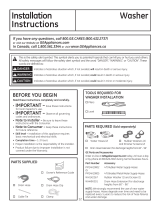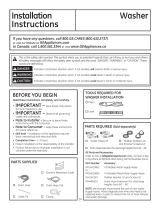
20 49-90567
Installation Instructions
ELECTRICAL REQUIREMENTS
CIRCUIT – Individual, properly polarized and grounded
15 or 20 amp circuit breaker or time-delay fuse.
POWER SUPPLY – 2 wire plus ground, 120 Volt, single
phase, 60 Hz, alternating current.
Outlet Receptacle – Properly grounded 3-prong
receptacle to be located so
the power cord is accessible
when the washer is in an
installed position. If a 2-prong
receptacle is present, it is the
owner’s responsibility to have
a licensed electrician replace it
with a properly grounded 3-prong
grounding type receptacle.
Washer must be electrically grounded in accordance with
local codes and ordinances, or in the absence of local
codes, with latest edition of the NATIONAL ELECTRICAL
CODE, ANSI/NFPA NO. 70 or CANADIAN ELECTRICAL
CODE, CSA C22.1. Check with a licensed electrician if you
are not sure that the washer is properly grounded.
If required by local codes, an external 18 gauge or
larger copper ground wire (not provided) may be
added. Attach to washer cabinet with a #10-16 x
1/2
”
sheet metal screw (available at any hardware store) to
rear of washer as illustrated.
Mobile Home Installation:
Installation must conform to Standard for Mobile Homes,
ANSI A119.1 and National Mobile Home Construction
and Safety Standards Act of 1974 (PL93-383).
GROUNDING INSTRUCTIONS
This appliance must be grounded. In the event of
malfunction or breakdown, grounding will reduce the
risk of electric shock by providing a path of least
resistance for electric current. This appliance is
equipped with a cord having an equipment- grounding
conductor and a grounding plug. The plug must be
plugged into an appropriate outlet that is properly
installed and grounded in accordance with all local
codes and ordinances.
Improper connection of the equipment-
grounding conductor can result in a
risk of electrical shock. Check with a qualified electrician,
or service representative or personnel, if you are in
doubt as to whether the appliance is properly grounded.
DO NOT modify the plug on the power supply cord. If it
will not fit the outlet, have a proper outlet installed by a
qualified electrician.
Attach ground
wire and ground
screw (obtain
locally)
Washer
back
Make sure large dial control (on some models) on
washer is pushed in to the OFF position.
Insert plug of electrical cord into a 115V, 15- or 20-amp
wall
receptacle. Move washer into final position. Place level on
flat top side edges of washer. Adjust all four leveling legs until
washer is level left-to-right and front-to-back. Remove level.
Open tub lid. Remove and discard tub shipping material (see
Step 1).
Remove plastic protector sheet from control panel face.
7
CONNECT POWER AND INSTALL
Level
Before starting the washer, check to make sure:
Main power is turned on.
The washer is plugged in.
The water faucets are turned on.
The unit is level and all four leveling legs are firmly
on the floor.
The shipping foam and cardboard are removed.
The drain hose is properly tied up.
There are no leaks at the faucet, drain line
or washer.
Run the washer through a complete cycle.
Check for water leaks and proper operation.
Place these instructions in a location near the washer
for future reference.
FINAL CHECKLIST
Ensure proper
ground exists
before use.
Plug into a grounded 3-prong outlet.
DO NOT remove ground prong.
DO NOT use an adapter.
DO NOT use an extension cord.
Failure to follow these instructions can result in death,
fire or electrical shock.
- Electrical Shock Hazard
WARNING
WARNING






















